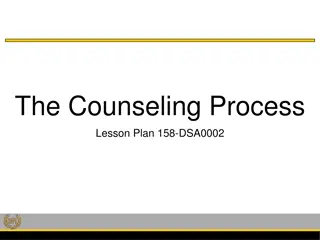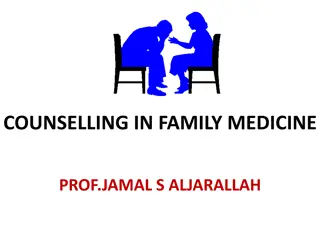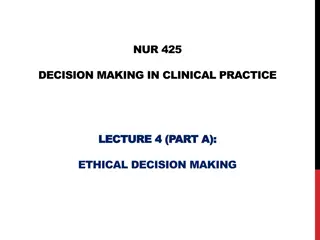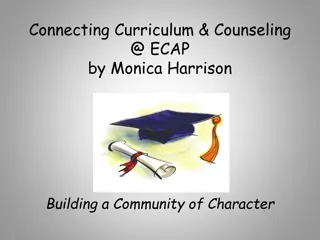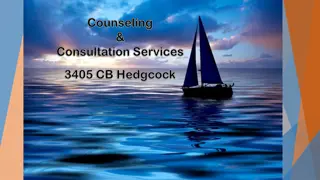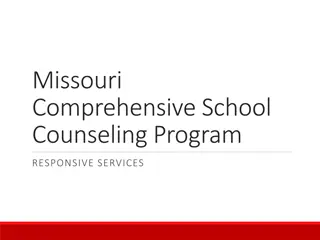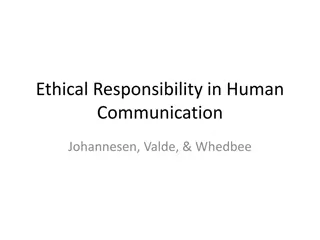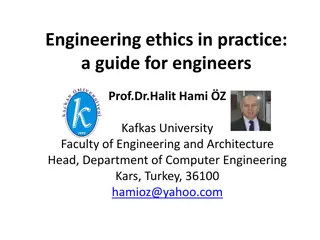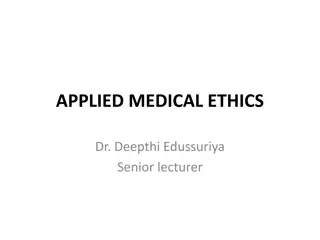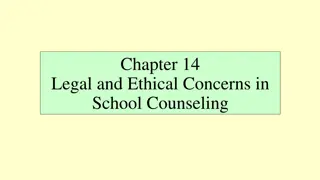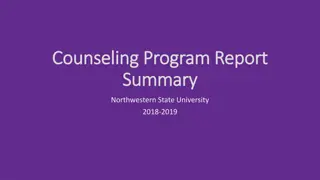Ethical Responsibilities and Positive Risk-Taking in Counseling Practice
This content discusses the ethical responsibilities and positive risk-taking in counseling practice, focusing on issues like safeguarding, intrusions, client relationships, and working with risk. Dr. Andrew Reeves emphasizes the importance of understanding and navigating risks effectively to provide the best support for clients. The content also highlights the need for a child-centered approach and creating a supportive culture within organizations to enhance safeguarding practices.
Download Presentation

Please find below an Image/Link to download the presentation.
The content on the website is provided AS IS for your information and personal use only. It may not be sold, licensed, or shared on other websites without obtaining consent from the author. Download presentation by click this link. If you encounter any issues during the download, it is possible that the publisher has removed the file from their server.
E N D
Presentation Transcript
Risk, Anxiety and Good Practice ETHICAL RESPONSIBILITIES AND POSITIVE RISK TAKING DR ANDREW REEVES
Counselling and its Systems National picture and developing expectations Law, Policy and Good Practice Key individuals and Family, Friends and Other Supporters experiences that shape more than 50 minutes per School, college or other young people s setting local policies and processes The Context week Young person, counsellor and the therapeutic exchange The Relationship
Intrusions and Influencing Factors Theoretical and conceptual understanding of the therapist Expectations of others How the client has been 'positioned' Structure: limited sessions; availability; funding Client presenting issues The Counselling Relationship Local policies and procedures Process and outcome measures Child protection expectations Confidentiality Safeguarding expectations
safeguarding is everyones responsibility: for services to be effective each professional and organisation should play their full part safeguarding
a child-centred approach: for services to be effective they should be based on a clear understanding of the needs and views of children safeguarding
Culture of organisation Support beyond the session Wider culture of key organisations Age, Safeguarding as a Specific Factor competence and self- support capacity Community expectations Safeguarding Tolerance of key organisational staff, e.g., safeguarding leads Policies and procedures Outcomes of previous interventions Tolerance of therapist Nature of disclosure or risk
Working with Risk We often approach risk from a binary position, i.e., risk is either present, or it isn t In actual fact there are aspects of risks in all our lives, all of the time: what we do is use information, and our own personal perspective, to navigate them Some situations are, comparatively, neutral to us others, such as suicide, often evoke stronger responses where our ethical position is clearer to us Reeves, A. (2015). Working with risk in counselling and psychotherapy. London: Sage
Exposure to the possibility of loss, injury, or other adverse or unwelcome circumstance; a chance or situation involving such a possibility So how might we define risk To act in such a way as to bring about the possibility of an unpleasant or unwelcome event, or To take a risk, be bold or daring Oxford English Dictionary, 2018
And what does that definition mean RISK IS ABOUT BEING EXPOSED TO DANGER OR UNCERTAINTY, OR THE POSSIBILITY OF THIS THE POSSIBILITY OF RISK CAN BE BROUGHT ABOUT BY OUR ACTIONS RISK IS NOT ALWAYS ABOUT DANGER, BUT CAN BE ASSOCIATED WITH BEING BOLD OR DARING
So, what do we specifically mean by risk Five different types of risk in the helping relationship: Situational Relational Contextual Professional Personal Reeves, A. (2015). Working with risk in counselling and psychotherapy. London: Sage
They relate to events or situations, or their potential, and in the context of a helping relationship relate to specific situations. For example: So what are situational risks Potential for client suicide Self-injury and self-harm Safeguarding concerns Child protection Risk of violence to others Terrorist threat Reeves, A. (2015). Working with risk in counselling and psychotherapy. London: Sage
In the helping context, such risks are embedded typically in the dynamic between the helper, and the person being helped. For example: And what about relational risks Sexual attraction Financial mismanagement or inappropriate interaction Unacknowledged or mismanaged transference issue Unacknowledged or mismanaged countertransference issue Actions that might deplete the client s autonomy or wellbeing Reeves, A. (2015). Working with risk in counselling and psychotherapy. London: Sage
Such risks relate to the context in which the helping relationship is delivered. For example: An inconsistent or inequitable delivery of service And then there s contextual risks Lack of clear ethical position in relation to the help being offered Inconsistent expectations of the helper in a working setting Poor working practices, or procedures Established relationship inconsistent with the ethos of helping Reeves, A. (2015). Working with risk in counselling and psychotherapy. London: Sage
Actions that might undermine our integrity in our helping role. For example: Being accused of an action that might lead to a criminal conviction Acting in a way that undermines a helpee s confidence in the act of helping itself, e.g., criticising the help offered within a context to the person being helped So what are professional risks Paying insufficient care and attention to the helping relationship and acting in a way that undermines it, e.g., working when exhausted, or under the influence of alcohol/drugs General actions in the public domain that lead to a negative association Reeves, A. (2015). Working with risk in counselling and psychotherapy. London: Sage
Risks that relate directly to the wellbeing of the helper. For example: Vicarious trauma Finally, what are personal Burnout Relationship or family difficulties Bringing personal matters into the helping relationship risks Inappropriate self-disclosure Meeting own needs in the helping relationship at the expense of the client Reeves, A. (2015). Working with risk in counselling and psychotherapy. London: Sage
Then There is Process Anxiety Therapist Anxiety Missing something Institutional Anxiety Missing something Getting it wrong Getting it wrong Being blamed Being blamed Failure to protect Failure to protect Reputational damage Reputational damage Loss of support options for client Loss of support options for client Loss of service Loss of service
Jake: Practice in Action
Jake Jake is 15 years of age He has come to see you as the school counsellor following a physical assault some months ago, presenting with trauma symptoms He is drinking heavily and has begun to self-injure He has intermittent suicidal ideation, which can impulsively move into suicidal intent (though has not acted on these thoughts) You have been meeting with him for several weeks and he has engaged well He mentions, in passing that, when he was 7 a family friend touched him sexually
Jake You ask him for more details His family has not had contact with this person for several years He refuses to give you this person s name You ask permission to inform the safeguarding lead of these concerns, explaining why He refuses. He says that while he is very unhappy about what has happened, he would only be able to tell someone when the time was right He become very distressed about the possibility of his confidentiality being broken and says he would not be able to live with this
Jake: Managing Historical Abuse To break confidentiality Ensures Jake s disclosure is taken seriously To maintain confidentiality Respects Jake s autonomy and his capacity to make informed decisions Creates an opportunity for exploration and further disclosure Respects his use of counselling and provides an opportunity for future disclosure he is in charge of Meet safeguarding concerns with respect to Jake s wellbeing Limits potential fractures in the relationship Acknowledges historical or ongoing risk in relation to others Responds to increased suicide risk
Safeguarding Responsibilities Suicide Risk Managing a Balance Safeguarding Responsibilities Historical Abuse
safeguarding a child-centred approach: for services to be effective they should be based on a clear understanding of the needs and views of children
Jake : his needs To be protected To be safe To be taken seriously To be believed To be responded to To be safeguarded
Jake : his views Wants to be in control Wants to manage the timing of interventions Wants to cope Wants to be heard Wants to trust his counsellor
Good Practice Parameters Clear, written agreements with the organisation about expectations Clear, written agreements with the young person communicating those expectations Clarity about contact with famllies Mutual agreements in place with supervisor Reflexive position with respect to risk and management of boundaries Understanding ethical expectations in the context of work Drawing on guidance from other agencies and settings, e.g., BACP: CYPF Willingness to communicate with, and challenge, professional organisations to ensure guidance remains current Write about practice and disseminate ideas (respecting confidentiality, obviously)
What do you expect of the organisation What does the organisation expect of you Clear, written agreements with the organisation What does the organisation understand of safeguarding in their context What is the culture of the organisation about positive risk-taking Who can be contacted, when, and how Ensure organisation is aware of ethical requirements for practice
Positive risk-taking is an important aspect of any helping relationship. Otherwise, the danger is that all helping relationships could become limited by the possibility of risk But, what is positive risk- taking Risk therefore, is not a binary concept (there is risk, there is no risk) Therefore, positive risk-taking is about: review risk regularly in the context of holding confidentiality putting in measures to mitigate the risk acknowledging risk
Critical the young person knows, and understands, what the boundaries of the relationship are Clear, written agreements with the These need to be communicating in a way, and at a time, that maximises the young person s understanding and engagement Need to be consistent with organisational expectations client Need to be acted on as, when and if required (do we know what required means?)
Is the supervisor aware of your organisation s expectations Does the supervisor understand the counsellor s own understanding and position Mutual agreements Does the counsellor understand the supervisor s understanding and position with Are all these points enshrined in a clear supervisory contract supervisor Does the counsellors know how to contact the supervisor, when they are available, and how to bridge the advice back into the setting
Wherever possible and appropriate, families need to be linked in with the counselling Clear parameters need to be agreed with the young people with respect to confidentiality Clarity about contact with families The experience of the family both positive and challenging is critical information and should not be diminished in its importance Families should be seen as a resource, not an inconvenience Systemic thinking should sit at the heart of all good therapeutic work
Does the counsellor fully understand what is meant by risk in the context How does the counsellor conceptualise positive risk-taking Reflexive position in relation to risk What is the personal position with respect to risk of the counsellor How does the counsellor ensure they retain a fully reflexive position How does the counsellors self-support when organisational and personal perspectives clash
What does the professional organisation say about ethics What do they say about work with children and young people Understanding How is a level of ethical engagement in practice retained, rather than a binary position in relation to ethics ethical expectations What does ethics mean in the particular working context Does the organisation understand ethical and practice requirements and have these been successfully negotiated
What do other counsellors in the area do Are their forums or meeting opportunities to share and discuss practice considerations Drawing on guidance from others How can learning be transferred successfully into the working context, in a way that involves all parties Are there specialist divisions or groups to help inform practice, e.g., BACP: CYPF Division What is the wider guidance from your professional organisation
How is a clear dialogue maintained with key staff in the institution How is a clear dialogue maintained with key others, e.g., family (while respecting the young person s confidentiality) Willingness to communicate with, and challange Professional organisations are keen to remain relevant to practice, but can drift away from that position if not communicating fully with the members Contribute to consultation mechanisms and write guidance information for others Share good ideas, and difficult times
Make contributions to professional journals and magazines Hold reflective practice sessions to connect with others including multi- disciplinary forums (avoiding introspective, self-fulfilling thinking) Write about practice and share ideas Involve young people in the development of services Use social media to communicate good practice principles (being mindful of the dangers of social media too) Consider Alliance and Advocacy as possible key aspects of work this helps position counselling as a social justice activity
Time for questions and comments Dr Andrew Reeves andrew-reeves.net
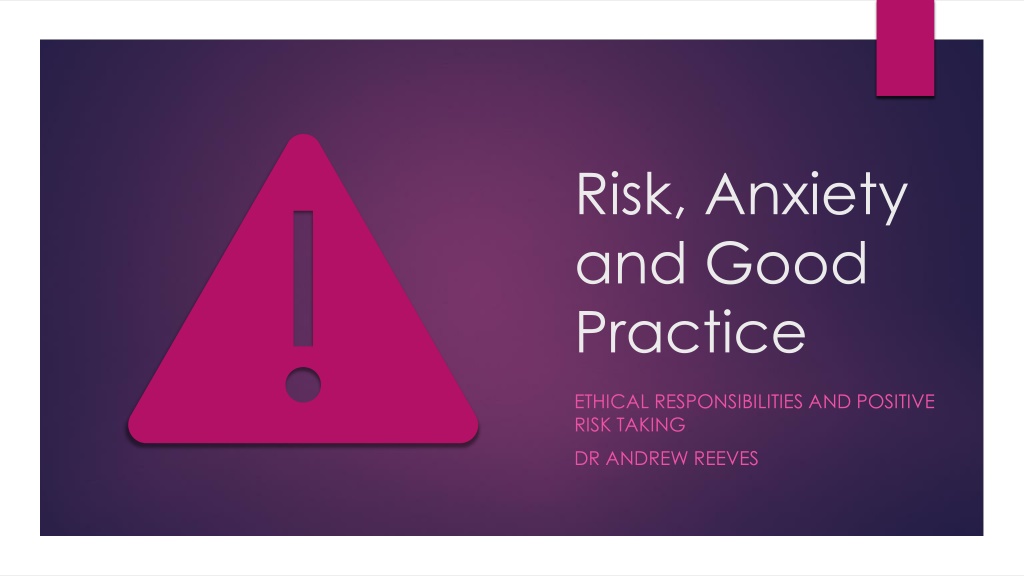
 undefined
undefined






















